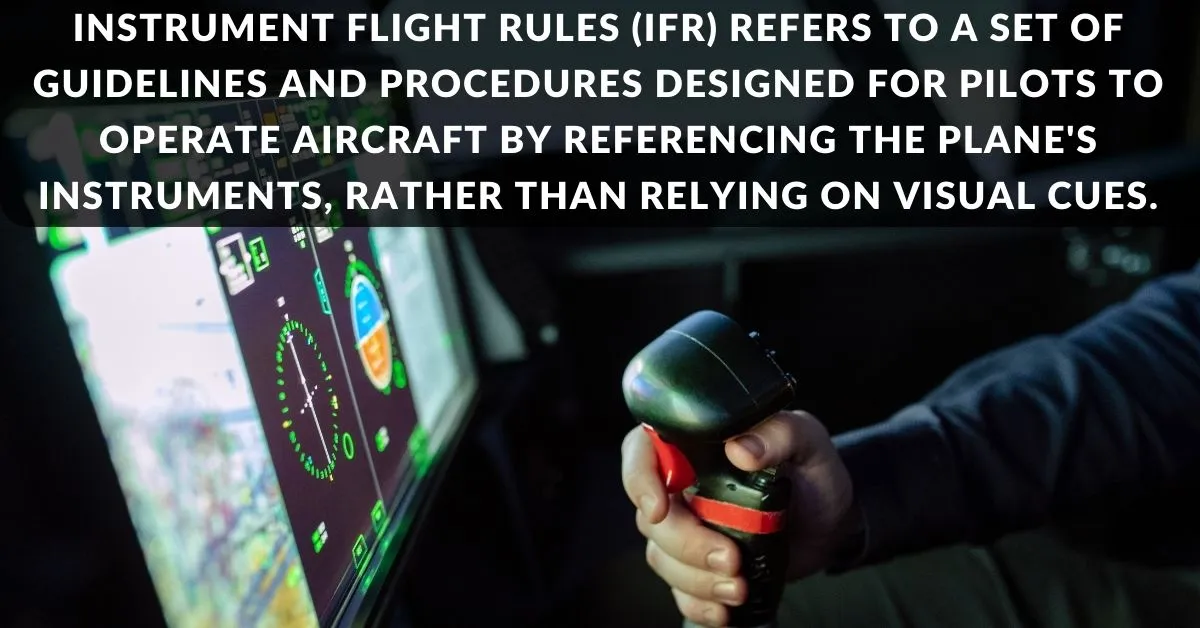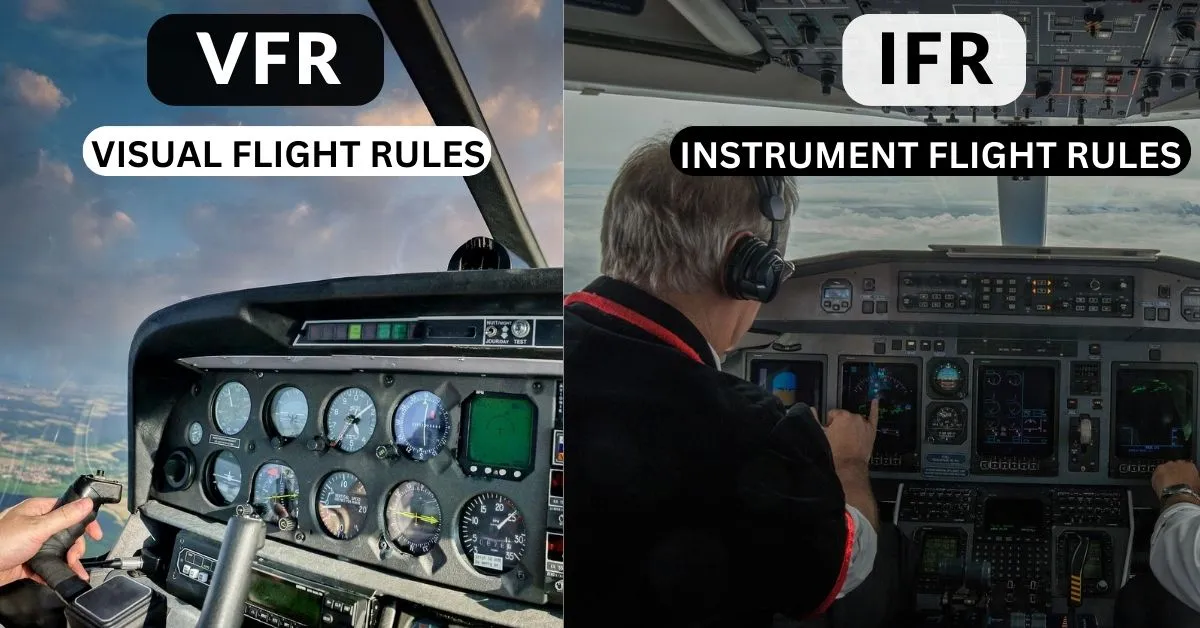Notice: Undefined index: titleWrapper in /home/u863873033/domains/aviatechchannel.com/public_html/wp-content/plugins/seo-by-rank-math/includes/modules/schema/blocks/toc/class-block-toc.php on line 103
In the realm of aviation, safety, and precision take center stage, especially where pilot training and flight operations are concerned. To this end, Instrument Flight Rules (IFR) play a pivotal role, often acting as a beacon of certainty amidst conditions of lowered visibility or darkness.
IFR not only compares intriguingly with Visual Flight Rules (VFR) but also strongly holds its ground as an essential aspect for maintaining safety and efficiency in aviation.
From understanding how exactly IFR functions, to acknowledging the training prerequisites, to IFR flight planning and operations, this compilation delves deep into these aspects, aiming to provide you with a comprehensive view of IFR’s relevance and applications in aviation.
Table of Contents
Understanding What is IFR in Aviation Operations.
IFR, or Instrument Flight Rules, are a set of regulations that dictate the conduct of flight under conditions in which flight by outside visual reference is not safe. In simple terms, IFR flight depends on flying by instruments in the flight deck, and navigation is accomplished by reference to electronic signals.
IFR procedures enable aircraft to safely fly and navigate in conditions where it would be dangerous or impossible to do so by sight alone, such as during heavy cloud cover, fog, rain, or darkness.
Understanding the Importance of IFR in Aviation
Instrument Flight Rules (IFR) significantly contribute to aviation safety, as they allow flights to navigate in less-than-ideal visibility conditions. The dependence on IFR eliminates the reliance on clear weather for aviation safety. It enables continuous air traffic operation amidst poor visibility, ensuring the streamlined and predictable nature of air travel.
For aviators, complying with IFR regulations, especially during difficult weather conditions, can be a potential lifesaver. It helps avert the risk of spatial disorientation, a dangerous scenario where a pilot cannot accurately gauge the aircraft’s position, motion, or attitude relative to the Earth’s surface.

IFR Requirements and Training
What is IFR in Aviation?
Instrument Flight Rules (IFR) refers to a set of guidelines and procedures designed for pilots to operate aircraft by referencing the plane’s instruments, rather than relying on visual cues, allowing for navigation under compromised visibility or challenging weather conditions.
However, to qualify for IFR, pilots must meet certain predetermined standards. Specifically, they need to possess a private pilot’s certificate at the very least, have logged a minimum of 50 hours of cross-country flight time as the pilot-in-command, and completed at least 40 hours of actual or simulated instrument time.
Earning an Instrument Rating
To earn their instrument rating, pilots require specific IFR training. Structured IFR training courses work on developing the pilot’s ability to control and navigate the aircraft by solely using flight instruments. This includes learning how to interpret and use the instruments effectively, understanding air traffic control procedures and clearance, and practicing emergency procedures.
It’s crucial for pilots to understand meteorology and weather data interpretation, as it significantly affects their ability to fly under IFR. The final step to earning an instrument rating is successfully passing the FAA Instrument Rating practical test, which includes an oral examination and a flight test.
Unlocking Opportunities in Aviation
In the world of aviation, earning an instrument rating is viewed as a major accomplishment. This esteemed rating equips pilots with the proficiency to operate under Instrument Flight Rules (IFR), enabling them to manage a host of potential in-flight situations. Greater skills and heightened confidence are not the only benefits.
Safety too is substantially improved as the pilot is well-prepared to smoothly navigate diverse weather conditions. Furthermore, holding an instrument rating could be a golden ticket to new flight opportunities, given the fact that it’s a prerequisite for many commercial airlines.
IFR Flight Planning and Operations
Understanding IFR, Instrument Flight Rules
What exactly does IFR represent? Instrument Flight Rules, or IFR, is a regulatory framework meant for pilots, guiding them to control their aircraft based solely on instrument readings, as opposed to visual cues from the ground. This approach proves vital especially during ‘instrument meteorological’ or low-visibility conditions such as navigating through dense clouds or turbulent weather.
Before embarking on an IFR-related journey, pilots lay out their intended path, altitude, and other relevant aspects in an IFR flight plan. The responsibility of reviewing and managing these plans lies with Air Traffic Control (ATC), tasked with the pivotal role of controlling and sequencing aircraft operating under Instrument Flight Rules.
Approaches and Procedures in IFR Aviation
There are several different types of instrument approaches, each requiring a different set of procedures. These approaches provide pilots with a guide to reduce their altitude until they can establish visual reference with the runway for landing.
Some common instrumental approaches include the ILS (Instrument Landing System), which provides both lateral and vertical guidance; the LOC (Localizer) and VOR (Very High-Frequency Omnidirectional Range), which only provide lateral guidance.
An important aspect of IFR operations
An important aspect of IFR operations is adherence to ATC instructions and specific operating rules that govern factors such as flight priorities, separation of aircraft, route assignment, and traffic advisories. For example, if two aircraft are on collision courses, the one on the right has the right of way.
Additionally, all such operations require the use of IFR charts, which depict airways, navigational aids, airports, controlled airspace, and special-use airspace. These charts provide pilots with crucial information to help them navigate safely during their flight in varied weather conditions ranging from fog to thunderstorms.
Navigating through the complexities of aviation, one realizes the extensive role played by IFR in maintaining safe skies. Overlaying an understanding of the training and stringent requirements, IFR charts, instrument approaches, and specific operating rules, we get a picture of the unwavering commitment to safety and precision in the aviation sector.
With IFR standing as a stalwart in ensuring an efficient hand-in-hand operation with ATC, it’s clear that flying under IFR becomes a calculation of weather, understanding, and skill. Undoubtedly, the realm of IFR widens the horizon of our understanding, sparking a greater appreciation for the remarkable persistence and precision involved in our aviation journeys.
Difference between IFR and VFR Operations

The Federal Aviation Administration (FAA) has established two primary operational standards, namely Visual Flight Rules (VFR) and Instrument Flight Rules (IFR), to govern aircraft operations. Under VFR, pilots primarily rely on external visual references to steer and control their aircraft.
VFR operations require generally clear weather conditions to ensure pilots have an unobstructed view of the aircraft’s path. The FAA mandates a minimum visibility of three miles during VFR conditions, and aircraft must maintain a specified distance from clouds. For night VFR flights, pilots have additional requirements, including ensuring proper lighting for their aircraft.
On the other hand, IFR is utilized when weather conditions drop below VFR minimums or when an aircraft operates in Class A airspace. IFR pilots heavily rely on the aircraft’s instruments for navigation and control, which is why the term ‘Instrument Flight Rules’ is used.
Operating under IFR demands a higher level of training and typically involves additional certification beyond that of VFR operations. Flying under IFR requires not only the ability to navigate using instruments alone but also proficiency in handling navigation and air traffic control procedures.
In terms of aircraft equipment, IFR-certified aircraft are usually equipped with more sophisticated navigation and radio equipment required for instrument approaches, whereas those intended for VFR flights can be simpler.
In regard to pilot licenses, IFR certification is necessary to fly in IFR conditions, while a basic private pilot license is sufficient for VFR flights. Although each set of rules has its own distinct requirements and procedures, both are aimed at ensuring safe and organized flight operations in all types of conditions and airspace.
Conclusion on ‘What is IFR in Aviation?’
In conclusion, IFR is a set of rules that govern aircraft that fly in instrument meteorological conditions (IMC). IMC is defined as weather conditions in which a pilot cannot maintain visual contact with the ground. Under IFR, pilots use instruments to navigate and control their aircraft. They also receive instructions from Air Traffic Control (ATC) to help them avoid other aircraft and other hazards.
IFR flying is a complex skill that requires extensive training and practice. However, it can be a very rewarding experience. IFR pilots are able to fly in any weather conditions, which gives them greater flexibility and freedom. They are also able to access more airspace, which can open up new destinations and opportunities.
If you are interested in learning more about IFR flying, there are many resources available online and in libraries. You can also take flight lessons from a qualified instructor. With hard work and dedication, you can become an IFR pilot and enjoy the many benefits that this type of flying has to offer.






